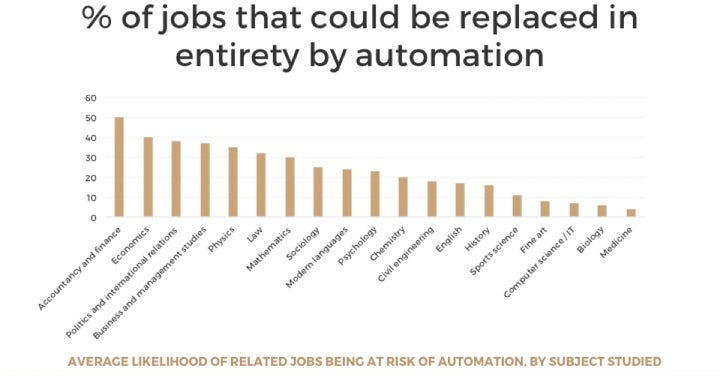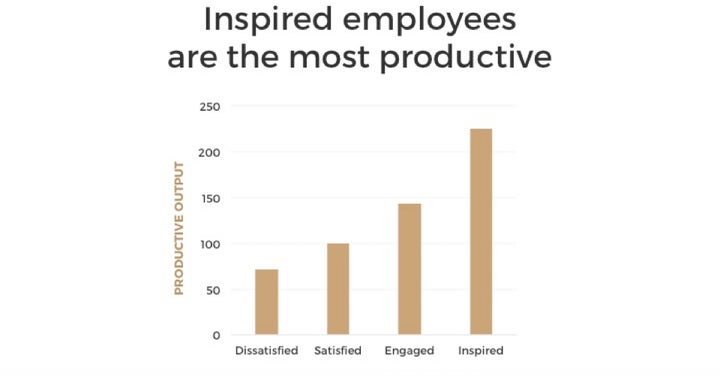
45% of our daily work activities could be automated using technology that we already have access to, so which skills will be most valued in the future workforce?
It’s likely that Artificial Intelligence will displace many human jobs, so are we heading for a conflict between artificial and emotional intelligence? (2)
Perhaps not. What if, rather than pushing humans out of the workplace, this development provides the opportunity to redesign our working life and unlock more of our unique human potential?
AI doesn’t need to sleep
A group of Oxford scientists evaluated the likelihood of various professions being displaced by automation. Jobs related to economics and accountancy were deemed to be most at risk (1).
Employers have long idolised ‘efficient working’ as the primary goal for their employees. However, when it comes to efficiency, we cannot compete with robots. AI promises a tireless, reliable, less error prone worker. AI rarely gets sick. AI doesn’t need to sleep.

(1)
Which human skills will become most important?
A recent survey set out to discover which human skills are likely to be most valuable in our automated future. Over 50% of the respondents, who represented various commercial institutions, suggested that an increased focus on STEM skills (Science, Technology, Engineering and Mathematics) is the highest priority.
However, ‘soft skills’, those associated with a person's Emotional Intelligence, were considered to be the second most important (3). ‘Service orientation’: actively looking for ways to help people and ‘originality’: creative problem solving and the capacity to generate unusual ideas, are two of four skills identified as least ‘automatable’ (3).
Organisations that can create an environment to develop and maintain human high-performance, with an emphasis on these features that are more difficult to emulate artificially, will possess a powerful competitive advantage.
So how can we develop these soft skills and creative characteristics?
Unlocking human potential
Robots work very well when they are switched on, fixed in place and left alone, but self-focus makes humans weaker and less resilient (5, 6). Humans need more than fuel for optimum performance.
In 2009 a group of researchers led by Professor Andrew Oswald published a paper in which they concluded that:
“different forms of evidence, with complementary strengths and
weaknesses, are consistent with the existence of a causal link between
human well-being and human performance.” (9)
Oswald’s colleague, Dr Sgroi, noted that:
“The driving force seems to be that happier workers use the time they have more effectively, increasing the pace at which they can work without sacrificing quality.” (10)
A growing body of evidence demonstrates that Emotional Intelligence, wellbeing and positive relationships are the foundations and precursors for improved human health and performance.
Inspired employees are the most productive
Emotional intelligence inspires, casts vision and emphasises the meaning in work. A study published last year suggests that one inspired employee can generate the same output as 2.25 satisfied employees. (8) Emotional intelligence helps us to create happy, healthy, high-performing teams.

(8)
Enhance and multiply your performance
The evidence demonstrates that applying and developing our Emotional Intelligence, discovering meaning and purpose, prioritizing our health and wellbeing, improving our ways of working and social interactions, enhance and multiply our performance in four ways:
Physically: We increase strength and cardiovascular health, reduce inflammation, reduce stress markers and boost our immune system.
Psychologically: We improve emotional balance and resilience, regardless of circumstances.
Socially: We strengthen existing relationships, build higher quality relationships, boost co-worker’s productivity, improve workplace commitment, increase engagement and provide superior customer service.
Intellectually: We learn faster, think more creatively and can better resolve challenging situations.
(11-28)
Perhaps it’s time to leave efficiency to the robots and use our emotional intelligence and human characteristics to become truly effective, unleash our originality and actively search for ways to serve and inspire each other, multiplying and amplifying our performance through our unique human contribution.
References
Frey, C.B. & Osborne, M.A. (Retrieved 16/05/2016) The future of employment: How susceptible are jobs to computerisation?; http://www.oxfordmartin.ox.ac.uk/downloads/academic/The_Future_of_Employment.pdf
Chui, M., Manyika, J., Miremadi, M. (Retrieved 16/05/2016) Four fundamentals of workplace automation; http://www.mckinsey.com/business-functions/business-technology/our-insights/four-fundamentals-of-workplace-automation
Frey, C.B. et al. (2016) TECHNOLOGY AT WORK v2.0. The Future Is Not What It Used to Be. Citi GPS: Global Perspectives & Solutions. http://www.oxfordmartin.ox.ac.uk/downloads/reports/Citi_GPS_Technology_Work_2.pdf
Van Dongen, H. P. et al. (2003) The cumulative cost of additional wakefulness: dose-response effects on neurobehavioral functions and sleep physiology from chronic sleep restriction and total sleep deprivation. Sleep. 26(2) p. 117-126
Coutinho, J.F. (2015) Default Mode Network Dissociation in Depressive and Anxiety States. Brain Imaging & Behaviour. EPub ahead of print.
MOR, N. & WINQUIST, J. (2002). Self-Focused Attention and Negative Affect: A Meta-analysis. Psychological Bulletin. 128 (4) p. 638-662
Cameron, K. et al. (2011) Effects of Positive Practises on Organizational Effectiveness. Journal of Applied Behavioural Science. 47 (3) p. 266-308
Horwitch, M. & Whipple, M. (Retrieved 16/05/2016) Leaders Who Inspire: A 21st-Century Approach to Developing Your Talent; http://www.bain.com/publications/articles/leaders-who-inspire.aspx
Oswald, A.J. (2009). Happiness and Productivity. Journal of Organizational Behavior. 20. p.35-30
Holloway, M. (Retrieved 16/05/2016) New study shows we work harder when we are happy; https://www2.warwick.ac.uk/newsandevents/pressreleases/new_study_shows/
FREDRICKSON, B.L. (1998). What Good Are Positive Emotions? Review of General Psychology. 2(3) p. 300-319
SUBRAMANIAM, K. et al. (2009). A Brain Mechanism for Facilitation of Insight by Positive Affect. Journal of Cognitive Neuroscience. 21. p. 415-432
TUGADE, M. & FREDICKSON, B. (2011). Resilient Individuals Use Positive Emotions to Bounce Back from Negative Emotional Experiences. Journal of Personality & Social Psychology. 86. p. 320-333
BOOTHBY, E.J. et al. (2014). Shared Experiences Are Amplified. Psychological Science. 25(12) p.2209-2216
GRAY, A.W et al. (2015). Laughter’s Influence on the Intimacy of Self-Disclosure. Human Nature. 26(1) p. 28-43
DUTTON, J.E. et al. (2010) Pathways of Positive Identity Construction at Work: Four Types of Positive Identity and the Building of Social Resources. Academy of Management Review. 35. p. 265-293
LILIUS, J.M. et al. (2008) The Contours and Consequences of Compassion at Work. Journal of Organizational Behaviour. 29. p. 193-218.
KANOV, J.M. (2004). Compassion in Orgnaizational Life. American Behavioural Scientist. 47. p. 808-827
LILIUS, J.M. et al. (2011). Compassion Revealed: What We Known About Compassion at Work (and Where We Need To Know More). The Handbook of Positive Organizational Scholarship. Oxford University Press. P. 273-287.
BAKKER, A. (2011). An Evidence-Based Model of Work Engagement. Current Directions in Psychological Science. 20. p. 265-269.
BARSADE, S.G. & GIBSON, D.E. (2007). Why Does Affect Matter In Organizations. Academy of Management Perspectives. 21. p.36-59
FOWLER, J.H. & CHRISTAKIS, N.A. (2008). Dynamic Spread of Happiness in a Large Social Network: Longitudinal Analysis over 20 Years in the Framingham Heart Study. British Medical Journal. 227. p.1-9
STELLAR, J.E. et al. (2015). Positive Affect and Markers of Inflammation: Discrete Positive Emotions Predict Lower Levels of Inflammatory Cytokines. Emotion. 15(2) p.129-133.
BERK, L.S. & TAN, S. (2009). Mirthful Laughter, as Adjunct Therapy in Diabetic Care, Increases HDL Cholesterol and Attenuates Inflammatory Cytokines and CRP and Possible CVD Risk. FASEB Journal, Supplement. 990.1
FREDRICKSON, B. & LEVENSON, R. (1998) Positive Emotions Speed Recovery from the Cardiovascular Sequelae of Negative Emotions. Cognition and Emotion. 12. p. 191-220.
SEPPALA, E. (2016) The Happiness Track. Piatkus.
Amabile, T. M. & Kramer, S.J. (2011) The Progress Principle: Using Small Wins to Ignite Joy, Engagement, and Creativity at Work. Harvard Business Review Press/.
Cadore, E. L. et al. (2014) Multicomponent exercises including muscle power training enhance muscle mass, power output, and functional outcomes in institutionalized frail nonagenarians. Age. 36(2) p. 773-785
